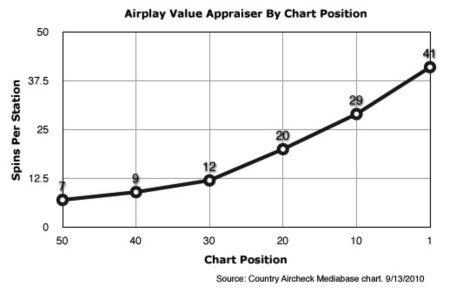
According to conventional wisdom and recent CMA research studies, radio remains a dominant force in shaping the country star constellation. Last year’s CMA study showed that 79% of country fans 18-54 listen to country radio. (The next largest category was 54% that visit the web once or more per month to find country music content.) More recent research has also shown that for country fans, broadcast radio (am/fm) continues to be the “No. 1 source of awareness for new music/artists and news.”
Recognizing radio’s importance as an exposure medium, it is no surprise that new, developing and established country artists place a premium on radio promotion to help move their music up the charts. With the added recognition conveyed by better chart positions and airplay, artists hope to reap benefits in the form of record, ticket and merchandise sales. But what exactly is the correlation between chart position, airplay, promotion costs and return on investment (ROI)? As our graph shows, there is little practical difference in weekly spins per station between No. 50 (7 spins) and No. 30 on the chart (12 spins).
“Over the last couple of years you start to feel some response around the Top 15,” says industry veteran Tom Baldrica who recently served as Sony Nashville VP Marketing. Baldrica was integral in artist development, new media and more for the label, plus previously headed its BNA Records Promotion team. “At that level on the radio side you can start to make a research impact and more importantly it places you in a position to start selling. But near the bottom of the chart, spins are one thing and audience impressions are another. If you look at a song at No. 50, 40 or 30, on any given station it’s being played less than two times a day and not being heard in daylight hours by any stretch of the imagination. Morning shows have the biggest cume. Mid-days are also very strong. Then there are afternoons and evenings where it drops off dramatically and finally overnights. So if you aren’t inside the Top 15 and in a rotation where your song is being heard 25-30 plus times a week at any particular radio station then the odds of people hearing it are slim and none. I’ve always thought of it as a Top 15 game and it could be even more of a Top 10 game right now for real volume.”
So what is Baldrica’s advice for indie artists? “You’re out of your mind to play the national chart game as an independent,” says Baldrica. “What you should be doing as an independent is looking regionally. If you’ve got a radio station playing your record then build around that airplay and get a network of stations within that little geographical area to play it. Folks in this game on the indie side don’t have the major label resources, the major label promo team and the major label leverage so they are better off building little fires. Build the opportunity to go into a region and be able to perform, get some airplay, sell some downloads and/or physical product and then return a few months later. Hopefully, if you are a good entertainer people will want to see you and bring a friend. You’ll double your crowd then double it again and again over time. That’s the way to chase it. The national charts thing is like trying to put a bunch of seeds on a large amount of acreage by yourself. You’re not going to get a lot of plants to grow. But if you focus on a small part of the garden, then nurture and water, some plants might start to grow.”
(Baldrica can be reached at tombaldrica@comcast.net)

About the Author
David M. Ross has been covering Nashville's music industry for over 25 years. dross@musicrow.comView Author Profile




